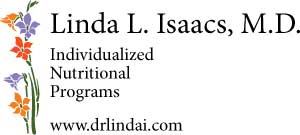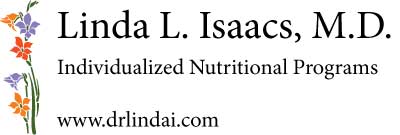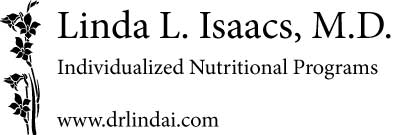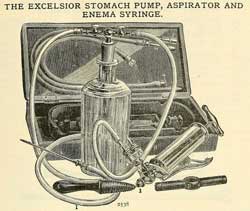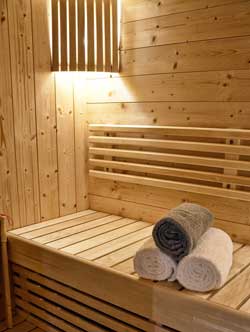Detoxification
The environment today is very different from the environment of our ancestors. Over the last 200 years, a host of chemicals has been introduced to our food, air, and water. Many of these chemicals have not been tested for safety, or are assumed to be safe since they are present in low concentrations. However, if many low-concentration pollutants are present, they may work together to have bad effects on our health. Some chemicals, such as the endocrine disruptors dichlorodiphenyltrichloroethane (DDT) and polychlorinated biphenyls (PCBs), have been banned in the United States for years, but persist in the environment and food chains. Exposure to pollutants is associated with chronic diseases, including coronary artery disease and diabetes.(Hoffman, Petriello, & Hennig, 2017)
A number of “detoxification” procedures have been developed that are thought to help eliminate these substances from the body. These protocols are critically important for patients as they embark on this program of intensive nutritional supplementation. Procedures such as coffee enemas, liver-gallbladder flushes, and saunas may help stimulate the body to rid itself of these waste materials and pollutants.
Coffee Enemas
Enemas (definition of enema) have been used for centuries to relieve constipation and improve general health and well-being, appearing in medical writings as far back as ancient Egypt. More recently, directions for administration of various types of enemas, including coffee enemas, were included in medical and nursing textbooks. (McClain, 1950; A General Practitioner, 1934) Coffee enemas were mentioned in the Merck Manual of Diagnosis and Therapy, a compendium of orthodox medical treatment, through the Twelfth Edition, published in 1972.
Coffee enemas have appeared in the medical literature for more than 150 years. In a case report in the Pacific Medical and Surgical Journal in December 1866, M.A. Cachot, MD, described successful use of a coffee enema to treat a child dying from an accidental poisoning. (Cachot, 1866) Articles from the late 1800s reported that coffee enemas were helpful in post-operative care. (Allison, 1896; “The Medicinal Employment of Coffee,” 1897) At a medical meeting in 1896, Dr. W.J. Mayo, one of the founders of the Mayo Clinic, mentioned coffee enemas as a routine part of care for patients after abdominal surgery. (“Mississippi Valley Medical Association Society Proceedings,” 1896) In an extensive 1941 article in the Uruguayan Medical, Surgical and Specialization Archives, Dr. Carlos Stajano described immediate improvement in near-terminal patients after coffee enemas, including a patient with cocaine intoxication and a patient with post-operative shock. (Stajano, 1941) His extensive experience with coffee enemas in post-operative management made him plead for their continued use. Unfortunately, the orthodox medical world turned away from the use of enemas and colonics in subsequent years, based not on sound research, but on a shift towards pharmaceutical therapies and a campaign against “quackery.” (Richards et al, 2006)
How do they work? Most likely by stimulating the liver and gallbladder to increase the flow of bile, aiding the liver in its detoxification efforts. In support of this, drinking coffee causes gallbladder contraction and elevates levels of cholecystokinin, a hormone that stimulates bile flow. (Douglas et al., 1990) In a 1929 paper in the Archives of Internal Medicine, investigators at Lenox Hill Hospital in New York reported that rectal installations of several different liquids caused an increase of bile flow from the liver. (Garbat & Jacobi, 1929) In a 2014 study, a group of gastroenterologists used coffee enemas as part of the preparation for video capsule endoscopy (swallowing a capsule with a small camera to photograph the insides of the small intestine). (Kim et al., 2014) They theorized that coffee enemas would stimulate bile flow, exhausting the supply so that bile would not be present in the intestinal tract to blur the images from the camera. They found that patients who had the coffee enema had better quality images than those who did not, suggesting that the enemas had indeed stimulated the release of bile stored in the gallbladder and bile ducts.
Some physicians claim that coffee enemas are dangerous, based on case reports of patients who reportedly developed electrolyte imbalances or infections after coffee enemas. (Eisele & Reay, 1980; Margolin & Green, 1984) Close review of these cases shows that the patients in question were seriously, even terminally ill, and that the infections or electrolyte disturbances blamed on the coffee enemas could have come about simply because of the patients’ underlying disease. Only a few such cases have been reported; to put this in perspective, every year in the United States, thousands of people die from the side effects of medications such as aspirin and ibuprofen, all available without a prescription. I have instructed many patients to perform coffee enemas and none have had any significant problems from them. However, I would also recommend that coffee enemas only be done after consultation with a qualified medical professional. Reference List
For more information, please see my 2021 review article, published in the peer-reviewed journal Alternative Therapies in Health and Medicine. And for a discussion of what roast is best for the coffee beans, click here.
Liver-Gallbladder Flushes
The liver is the primary detoxification organ in the body, and many of the wastes it processes are eliminated in bile, which travels from the liver through the bile duct to the small intestine. In addition, bile contains bile salts, necessary for the digestion of fat. Bile is stored in the gallbladder, an organ connected to the bile duct in between the liver and the small intestine; when a fatty meal is eaten, the stomach and intestine send a signal to the gallbladder to contract, expelling bile into the intestinal tract to aid in digestion.
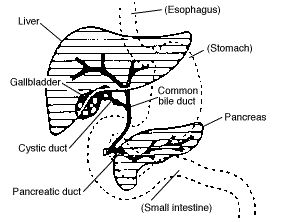
Stones or sludge can form within the gallbladder, which may then block the opening through which bile flows. This can cause nausea and abdominal pain after eating a fatty meal, as the gallbladder tries unsuccessfully to squeeze out its contents. Gallstones can also travel into the bile duct and become stuck, leading to infection, or migrate into the pancreatic duct (which connects to the bile duct) and cause acute pancreatitis. Either of these conditions can be life-threatening. The most common treatment for gallstones is removal of the gallbladder; 750,000 Americans undergo this operation each year.
The liver-gallbladder flush is an old technique to help stimulate and cleanse the bile ducts and gallbladder, and relieve the nausea and abdominal pain experienced by patients with symptomatic gallstones. There are several variations, but all include drinking oil, usually olive oil, which induces vigorous contraction of the gallbladder. Typically, round green objects pass in the stool the next day, traditionally believed to be passed gallstones. (Dekkers, 1999) However, in a letter to the journal Lancet, doctors in New Zealand reported that chemical examination of such objects brought in by a patient after a liver-gallbladder flush revealed that the “stones” were most likely created from the olive oil that she drank to do the procedure. (Sies & Brooker, 2005) The authors claimed that this proved the procedure doesn’t work, but identifying the green objects that passed in this individual patient as olive oil derivatives doesn’t answer the question of whether the procedure can be successful in stimulating stones or sludge to pass or in relieving symptoms from gallstones.
In a small study presented at the 1997 meeting of the North American Primary Care Research Group and subsequently described in American Family Physician, Richard L. Garrison, MD, studied the effect of a “traditional home remedy for inducing gallstone expulsion using lemon juice, olive oil, cascara sagrada and garlic/castile enemas” in 6 patients with symptomatic gallstones which had been confirmed by ultrasound. (Garrison, 1998) An ultrasound after the procedure assessed clearing of stones. Alter completing the liver flush, five of six patients were asymptomatic for periods ranging from two to 27 months. At least one woman cleared all her stones, but she proceeded with an operation anyway at the advice of her surgeon. The investigators concluded that the procedure could potentially eliminate the need for surgery in many patients. Reference List
Saunas
Many traditional cultures utilized some form of cleansing in hot environments such as steam baths, sweat lodges, and saunas. In Finland, saunas are regularly used by much of the population, and researchers there have investigated the health benefits of saunas. An article in the journal Neurology reported that those who take frequent saunas have a reduced risk of stroke. (Kunutsor et al., 2018) The researchers established baseline habits of sauna bathing in a group of Finnish men and women aged 53-74, then followed them for nearly 15 years. Those who were classified as “frequent” sauna users were much less likely to have a stroke than those who did not use them at all; the association was still seen even after correction for other known risk factors for stroke, and after adjustment for socioeconomic status and for physical activity levels. The same group of researchers found that sauna use was associated with a reduced risk of respiratory conditions. (Kunutsor et al., 2017)
While at one time it was rare for Americans to have saunas in their homes, infrared saunas have become more affordable. Spas and gyms may also have them. Reference List
Does Detoxification Work?
Induced sweating, such as provided by saunas, may be a valuable way of ridding the body of some types of toxins. The “Blood, Urine and Sweat” studies by Dr. Stephen Genuis and colleagues have demonstrated that significant amounts of flame retardants (S. K. Genuis, Birkholz, & Genuis, 2017), organochlorine pesticides (S. J. Genuis, Lane, & Birkholz, 2016), PCBs (S. J. Genuis, Beesoon, & Birkholz, 2013), phthalates (S.J. Genuis, Beesoon, Lobo, & Birkholz, 2012), and BPA (bisphenol A) (S. J. Genuis, Beesoon, Birkholz, & Lobo, 2012) can be excreted in sweat.
There are various pragmatic difficulties in formal studies on detoxification, because toxins can be stored in bone, muscle, or fat, tissues that are harder to sample and analyze than blood, urine, or sweat. However, a study published in Alternative Therapies in Health and Medicine looked at the efficacy of Ayurvedic cleansing procedures for removal of fat-soluble toxins such as PCBs. (Herron & Fagan, 2002) In this publication, among participants who performed the cleansing procedures (which included herbal enemas and ingestion of oil), blood levels of PCBs showed a substantial decrease.
Patients report that they feel better as a result of doing these detoxification procedures, and for almost all of them, once they try them they are sure of their benefits. However, anyone interested in pursuing these techniques should consult with a knowledgeable medical professional for direction.
Reference List
Click on the name of the section to return to Coffee Enemas, Liver-Gallbladder Flushes, or Saunas.
A General Practitioner. The Illustrated Family Doctor. Dunstable: Waterlow and Sons; 1934.
Allison CC. Operative Technique in Appendicitis, with Cases. West Med Review. 1896;1:152-154. Full text available at http://google.com/books?id=tOVXAAAAMAAJ.
Cachot MA. Case of Poisoning by Aconite; Enema of Coffee in the Treatment. Pac Med Surg J. 1866;9:239-240. Full text available at http://google.com/books?id=BkAgAQAAIAAJ
Dekkers R. Apple juice and the chemical-contact softening of gallstones. Lancet. 1999;354:2171. PMID 10609857
Douglas BR, Jansen JB, Tham RT, Lamers CB. Coffee stimulation of cholecystokinin release and gallbladder contraction in humans. Am J Clin Nutr. 1990;52:553-556. Abstract available at www.ncbi.nlm.nih.gov/pubmed/2393014
Eisele JW, Reay DT. Deaths related to coffee enemas. J Am Med Assoc. 1980;244:1608-1609. PMID 7420666
Garbat AL, Jacobi HG. Secretion of bile in response to rectal installations. Arch Intern Med. 1929;44:455-462. Abstract available at jamanetwork.com/journals/jamainternalmedicine/article-abstract/536575
Garrison RL. Home Remedy May Help Prevent Surgery in Some Patients with Gallstones. In: Rose VL. Conference Highlights. Am Fam Physician. 1998;57:785-786. Full text available at http://www.aafp.org/afp/1998/0215/p785.html.
Genuis SJ, Beesoon S, Birkholz D. (2013). Biomonitoring and Elimination of Perfluorinated Compounds and Polychlorinated Biphenyls through Perspiration: Blood, Urine, and Sweat Study. ISRN Toxicol. 2013:2013:483832. Full text available at www.hindawi.com/journals/isrn/2013/483832
Genuis SJ, Beesoon S, Birkholz D, Lobo RA. Human excretion of bisphenol A: blood, urine, and sweat (BUS) study. J Environ Public Health. 2012;2012:185731. Full text available at www.hindawi.com/journals/jeph/2012/185731
Genuis SJ, Beesoon S, Lobo RA, Birkholz D. Human elimination of phthalate compounds: blood, urine, and sweat (BUS) study. Scient World J. 2012;2012:615068. Full text available at www.hindawi.com/journals/tswj/2012/615068.
Genuis SJ, Lane K, Birkholz D. Human Elimination of Organochlorine Pesticides: Blood, Urine, and Sweat Study. Biomed Res Int. 2016;2016:1624643. Full text available at www.hindawi.com/journals/bmri/2016/1624643
Genuis SK, Birkholz D, Genuis SJ. Human Excretion of Polybrominated Diphenyl Ether Flame Retardants: Blood, Urine, and Sweat Study. Biomed Res Int. 2017;2017:3676089. Full text available at www.hindawi.com/journals/bmri/2017/3676089
Herron RE, Fagan JB. Lipophil-mediated reduction of toxicants in humans: an evaluation of an ayurvedic detoxification procedure. Altern Ther Health Med. 2002;8:40-51. Abstract available at www.ncbi.nlm.nih.gov/pubmed/12233802
Hoffman JB, Petriello MC, Hennig B. Impact of nutrition on pollutant toxicity: an update with new insights into epigenetic regulation. Rev Environ Health. 2017;32(1-2),65-72. Full text available at www.ncbi.nlm.nih.gov/pmc/articles/PMC5489226
Kim ES, Chun HJ, Keum B, et al. Coffee enema for preparation for small bowel video capsule endoscopy: a pilot study. Clin Nutr Res. 2014;3(2):134-141. Full text available at synapse.koreamed.org/DOIx.php?id=10.7762/cnr.2014.3.2.134
Kunutsor SK, Khan H, Zaccardi F, Laukkanen T, Willeit P, Laukkanen JA. Sauna bathing reduces the risk of stroke in Finnish men and women: A prospective cohort study. Neurology. 2018;90(22):e1937-e1944. Abstract available at www.ncbi.nlm.nih.gov/pubmed/29720543
Kunutsor SK, Laukkanen T, Laukkanen JA. Sauna bathing reduces the risk of respiratory diseases: a long-term prospective cohort study. Eur J Epidemiol. 2017;32(12):1107-1111. Abstract available at www.ncbi.nlm.nih.gov/pubmed/28905164
Margolin KA, Green MR. Polymicrobial enteric septicemia from coffee enemas. West J Med. 1984;140:460. Full text available at www.ncbi.nlm.nih.gov/pmc/articles/PMC1021723
McClain ME. The patient's needs: Enemas. Scientific Principles in Nursing. St. Louis, MO: The C.V. Mosby Company; 1950:168.
The Medicinal Employment of Coffee. Sanitary Record. 1897;20:105S-106S. Full text available at books.google.com/books?id=tS0TAAAAYAAJ
Mississippi Valley Medical Association Society Proceedings. West Med Review. 1896;1:189-194. Available at http://google.com/books?id=tOVXAAAAMAAJ.
Richards DG, McMillin DL, Mein EA, Nelson CD. Colonic irrigations: a review of the historical controversy and the potential for adverse effects. J Altern Complement Med. 2006;12(4):389-393. Full text available at https://www.meridianinstitute.com/reports/colonic.pdf
Sies CW, Brooker J. Could these be gallstones? Lancet. 2005;365:1388. PMID 15836886
Stajano C. The concentrated coffee enema in the therapeutics of shock. Uruguayan Med Surg Special Arch. 1941;29:1-27.

